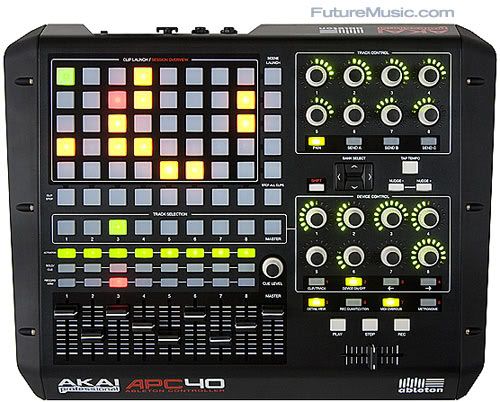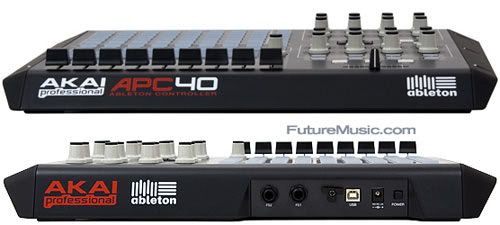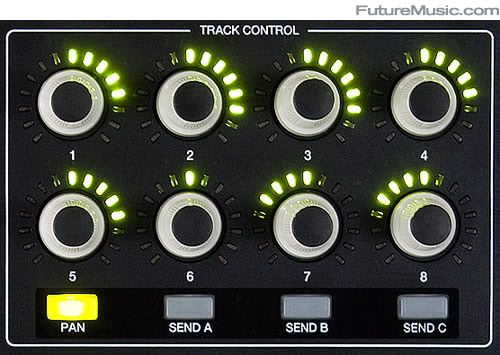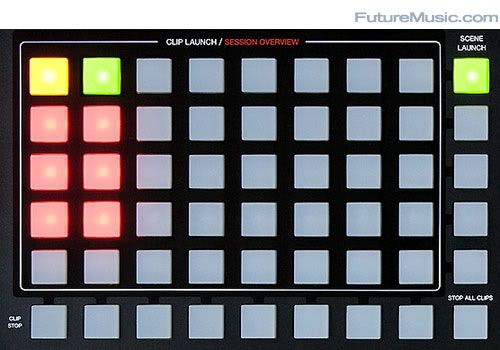Hi all, this is a review of APC40, the long-waited Live controller. See if it is worth the wait. Enjoy:)
From Future Music
The new APC40 from Akai and Ableton has caused quite a stir within the tight-knit community of Live users since it was first announced at the 2009 NAMM show. News of the first Ableton-sanctioned USB MIDI controller spread like wildfire around the globe via the Internet, magazines and other media outlets who waxed poetic on the concept, and its potential effect on the user base. Even with the considerable pre-orders, Akai has limited the chest-thumping to a careful and strategic promotional campaign, which now includes the new APC40.com website.
We recently had the opportunity to spend some quality time with the APC40, and have determined, for the most part, the controller lives up the hype. But, don't call it a controller. What Akai has produced in some ways is really more of an instrument, than merely a MIDI controller. In fact, the APC40 brings back Live to its roots as a performance application, and not a Digital Audio Workstation (DAW), a moniker that Ableton tried to adopt in order to shoehorn the dynamic application into a retail product category.
Many Ableton Live users were never quite comfortable with the DAW term due to its status as the "Audio Swiss Army Knife" and its ability to adapt to various applications and play nice via Rewire with other true DAW's including Logic and Cubase. This doesn't mean that the APC can't become the centerpiece of users composing their latest opus with Live, it can, but for musicians who have been waiting, for what seems like eternity, for an intuitive, tactile hardware interface for Ableton's finest, the wait is finally over.
Features:
* All Knobs, Buttons & Sliders are customizable
* Clip Launch Button Matrix
* Session Overview
* Mixer Section
* Track Selection & Device Control Encoders
* Transport Control
* Track Control
* Tempo Control
* Crossfader (but is located too close to mission critical Stop Play Record buttons)
* Turn The Grid Matrix Into A Step Sequencer With The Upcoming Max For Live
Considering what other companies call "Plug 'n' Play," you'll be happy to note that the APC40 is truly a plug in, and get down to business affair. Simply launch Live, plug in the USB cable and then choose the APC40 as your controller of choice in Live's preferences. That's it, you're done.
The Akai APC40 features bidirectional communication between the controller and Live. This means that any tweaks that you make on the APC will show up visually in the application and vice-versa. This is a key feature that allows users to jump back and forth between the software and the hardware without any guess work.
More experienced users, will bypass the manual and start exploring, while the skittish will open up the QuickStart guide to assist them. Unfortunately, besides defining the geographical areas of the device, and the button states, there's not a lot there to assist you. Don't panic.
The APC40's layout is logical and instantly familiar. A matrix of small rubber buttons correspond to the session view, with eight small-throw volume faders, plus one master fader lined up underneath. On the right hand side you'll find two banks of eight plastic knobs with LED position rings, sandwiching hard buttons for bank selection, tap tempo, shift and nudge. Just below are the Live command and transport controls with a basic crossfader underneath.
The construction quality of the APC40 is first rate, with a metal chassis and rubber textured side panels for a solid and no-slip grip. All the rubber buttons have a great feel and make you want to trigger clips as soon as you get your grubby hands on the device. The faders are smooth with just enough resistance to be precise. The knobs, while solid and secure in the ciruit board, were deemed a tad "plasticy" by some of our reviewers who felt "they fall short of the overall quality of the APC." Indeed, one of the black plastic caps popped off during the unboxing, but snapped right back into place without any drama. A "rubber coating" on the knobs would have appealed to one of the evaluators for "tweaking under sweaty conditions." The proximity of the faders to one another may also prove to be an issue with a small group of users who are used to some "breathing room" when adjusting volume. Although, one of our testers liked how he could manipulate "two faders with one hand" during his workout with the unit.
The 8 x 5 grid of main Clip buttons have four states: Off - empty clip slot, Amber - clip present, but not playing, Green - clip present and playing, and Red - clip recording. Clip Stop buttons are located immediately below the main grid with Scene Launch buttons to the right. The Scene Launch buttons trigger an entire horizontal row of Clips (called a "Scene" in Live). Just below the Clip Stop row is the Track Select row, which determines the track that is being controlled by the Device Control Knobs to the right. Below are three rows of half-buttons, which are Track Mute, Solo/Cue and Record Arm respectively.
Based on Ableton's Session view, the main grid of buttons are an obvious interface choice that has been already field tested by several controllers currently on the market including the Livid Instruments' Ohm and the Mononom. Where things got a little sticky with our testers was with the knobs and button layout on the right. Three of our testers took issue with the "ergonomic choices" Akai made, as well as the number and "poor layout of the knobs." The other two testers felt that they "would get used to the workflow" and "adapt to the current layout" after "just a few sessions" with the unit.
The biggest hurdle that the first camp noted was that the Bank Select, Tap Tempo, Shift and nudge buttons "sat in a trough of knobs," which ended up "hampering access" and for one tester "cramping my wrists." Another tester felt that Ableton "missed a big opportunity to create a proper channel strip" and that he would have a "preferred a vertical work flow." Others felt that "the top group should have contained a 2 by 4 group of larger rubber-coated knobs for tweaking with a 3 by 4 group of 12 knobs beneath for EQ or Sends."
All of the reviewers "loved the LED-Rings around the knobs," as well as the "bright back-lit buttons." However, everyone commented that the right hand side could of incorporated a few "more assignable buttons under the knobs" for personalized workflow. The crossfader on the bottom "seemed like an afterthought" and "is positioned way too close to the mission critical Play, Stop and Rec buttons." A serious mis-step to anyone "who engages in passionate crossfades." That said, everyone figured they would incorporate it in some way into their sets. "Crossfaders can be great effects controllers, if you do it right."
During our stint with the APC40, the unit never got overly hot or had any USB issues. The multi-directional MIDI flow never bogged down or got overwhelmed no matter how much we tried to crash it - even with one tester simultaneously tweaking the software while another punished the APC40's controls. Our reviewers all commented that they felt Akai nailed the size of the unit, not too big, not too small and not too light and not too heavy. Aside from one or too gripes about the knob choice, the unit impressed each tester with its "solid build" and "quality fit and finish."
Although the ergonomics are not perfect, we feel that the Akai APC40 delivers. The Ableton community has had to wait far too long for a dedicated hardware "instrument" that squarely puts the focus back on performing. With a street price of only $399, Akai and Ableton have provided tremendous value to the consumer with the APC40. Hopefully, there will be more hardware collaborations between these two players, and maybe even a ménage à trois with Serato, which will continue to push the envelop and position Live firmly where it belongs, in a class by itself.
The Future: If Akai decides to debut an APC40 MKII refresh, or a next generation APC60, they should rethink the right side controls, which some of our reviewers found troubling. A revamped configuration with different controls, such as a trackpad, a more performance-oriented layout and better ergonomics would enhance the end-user's experience.
Equipment - Controller - Akai ACP40
Friday, 24 July 2009Posted by WIN at 19:45
Labels: Ableton live Techniques, Equipment Reviews
Subscribe to:
Post Comments (Atom)


0 comments:
Post a Comment